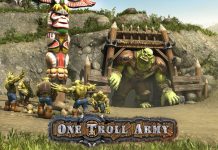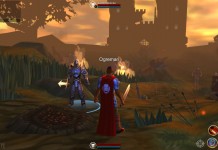Hardcore PvP action and cute animé characters are not the sort of hybrid you expect in an MMORPG—to that end, Asda 2: Evolution is not exactly the expected game. Basically a sequel to already critically acclaimed Asda Story, free-to-play Asda 2 is published in the USA by GamesCampus. It supports itself with the standard RPG model with a hovering camera, 3D graphics, and a game world containing lots of monsters to kill and a hardcore PvP system as players advance in the ranks.
As I haven’t reviewed nor played its ancestor, Asda Story, this review is not comparative to any advance in technology.
Overall, I wasn’t that impressed by the graphics or the sound quality in the game; however, it didn’t skip, lag, or slow so they’re doing something right. The low polycount modeling with high contrast textures may be how they handle such a large game world that expects to compel players to clash without grinding their clients to a halt.
The game employs nProtect to stop people from hacking or cheating the gaming engine so watch out for that appearing in your taskbar.
Graphics and Sound: A little too smooth but it gets the task done
Upon first arriving the game looks like its graphics engine is very cartoony and appears to have a low polycount for the models. Trees and houses are blocky and rely heavily on textures. The characters are very round and cute, with accessories that hug the player and share model types by varying textures. Don’t run this game in a window, the text becomes too small and it doesn’t anti-alias well (even when that’s turned way up.)
Though, I was impressed by how far away from my character the game would let me zoom out—to the extent that zooming in showed that the graphics engine is quite capable of handling both distant and close detail with equal alacrity.
When zooming, the game handles occluding objects by making them transparent. This means that you won’t suffer at whatever zoom level you’ve set because your camera won’t jump around to avoid objects and will stay on your character. It also adds to the overall cute and cartoon effect the game provides as trees, rocks, and buildings vanish as you race across the landscape.
For some reason, the graphics themselves just rubbed me the wrong way.

Much of the interaction with NPCs is done through dialogs that show an animé inspired graphic of them in rather than just popping up a message window.
The message windows can actually be a little bit of a problem as some of them can become long enough to require them to scroll. This can get a little odd because they’re strangely shaped already. The message window itself is displayed as a cloud above the manga-portrait of the character you’re talking to. In true animé fashion, the attributes of the character you’re talking to are exaggerated in their portrait—girls have tight shirts that display ample curvature, and boys are often bishōnen with fragile physiques in spite of armor and muscle.
The graphics fare well enough in combat where FX displays slashes and strikes. There’s also a screen flash when a critical hit is scored, which is actually pretty nice because it adds a sense of excitement.
The sounds seem a bit subdued and I barely noticed them. Well, except for the constant music, which is common to these games. Arrows, spells, and sword swipes all produce sounds as does the signal that you’ve completed a task or turned something in.
Gameplay: Basic RPG with autoroute
Asda 2 supports all the basic RPG UI elements learned from every other MMO before them although it adds a few differing features. The UI feels a little bit raw, but it suits all of its functions. Many of the features are hidden behind a folding icon-menu that at first seems confusing but is quickly intuitive (and you won’t forget what button does what after a little experimentation.)
Travel consists of the WASD keys along with a click-to-move function. Also, for the weary, there’s an autoroute function that can be triggered when a quest is available that will take your character directly to the quest spot (to kill monsters) or to the turn in when it’s done. I availed myself of this function several times while writing this review so that I could have my character rush place to place without me while I inked words onto the page.
Instead of looting downed corpses, fallen enemies drop their goods on the ground where it must be grabbed—or picked up by pressing the “pick up loot” key. It seems a little strange at first, but it’s another function that I was quick to take to.
Healing and mana potions aren’t instant—instead they take act in mana- and heal-over-time displaying a portion of the health- or mana-meter that will be filled up. This means that if you’re taking a pounding in combat you’ll want to hit the heal potion before you need it; otherwise, you might find yourself in dire straights waiting for the potion to top you off.
Once again, there seems to be no way to invert mouse Y-axis in this game. I wish more would add that feature.
Social System: A fair number of emotes and soul mates
There seems to be a pretty large emote system in the game. I didn’t play with it much, but there’s enough to make it a good communication system.
We’ve seen the soul mate system before (talking about Lucent Hearts here) and it seems that the system used by Asda 2 retains some similarities. The soul mate system has also evolved into an in-game marriage system. According to the hype, playing with soul mates/spouse partners in game provides a lot of benefits from quicker XP gain to increases in overall power (probably defense and attack.) I didn’t get a chance to actually examine this functionality as I don’t have anyone to explore brand-new games with.
However, with this element of the social system, Asda 2 will probably see a lot of players who look for partners to play the game alongside.
Conclusion: As a next generation RPG it doesn’t stand out, but it does stand up
Asda 2: Evolution boasts a strong lineage and as it’s a sequel of an already functional game it’s got a solid foundation to stand on. The graphics may not be for everyone, but they’re not terrible either. The game runs on a relatively quickly downloaded footprint and expands to about 2.5 gigabytes once installed. A fairly large community has already flooded into the game and there’s likely enough to cover both sides of the PvP fights.
Didn’t get to see much PvP during my first impressions, but the game publisher does trumpet this aspect as a selling point.
If you’ve got someone else you like playing games with and you like animé-cute coupled with 3D RPG, then this could be your game. The soul mate/marriage system would make it an ideal game for couples who want to play together. As a result, it might be attempting to edge into the romantic department in drawing pairs of players into the game world.
We’ll have to see where this one goes.






















Very interesting. Might have to try it out just to try.
My only complaint is that this game is now in open beta, and I cant seem to find any official information on classes, or skills. Not even on the forums.
True enough, @Donadl. I wasn’t able to get far enough into the game to fully appreciate the different classes. The character I started with was an archer–at the very beginning it looks like there’s three basics: Archers (bows), Warriors (swords), and Mages (staves.)
Once you proceed to level 24, you’re able to “evolve” your class into another one along the same chain. I haven’t seen a fact sheet on what those chains lead to or how they interact, I’m afraid. I will keep it in mind when one comes out to post something to help you out.